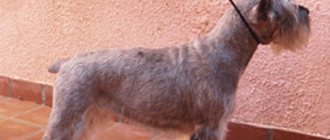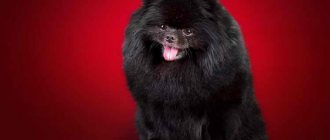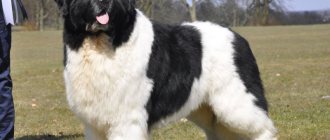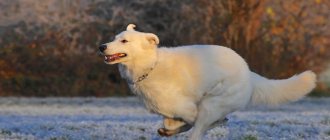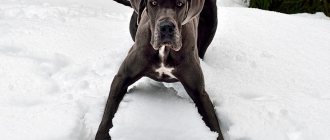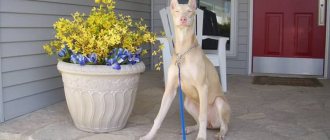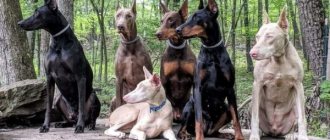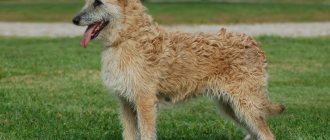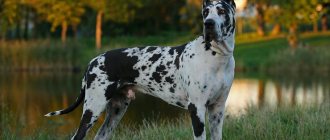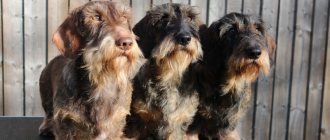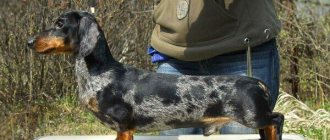Dossier
Adult height: standard 20-27 cm, average 14-21 cm, miniature 10-15 cm. Weight: standard 6.5-11.5 kg, average 3.5-5 kg, miniature 3-3.5 kg. Characteristic color: the main color is black, auburn or dark gray with small random gray or beige spots. Coat length: wire-haired, long-haired, smooth-haired. Life expectancy: 15-18 years. Advantages of the breed: intelligent, with an unusual appearance. Difficulties of the breed: stubborn, prone to obesity. Average price of a marbled dachshund: $50-300. Classification: medium, hound, hunting breed.
Varieties of marbled dachshunds
Depending on the appearance and characteristics of the exterior, marbled dachshunds are divided into several groups.
By length and type of coat:
- smooth-haired;
- long-haired;
- Wire-haired.
To size:
- standard;
- dwarf or miniature;
- rabbit
The marbled dachshund is the smallest, weighing no more than 3.5 kg. The standard one weighs 9-12 kg, the dwarf one – up to 5 kg.
By eye color
The appearance of dachshunds is quite impressive. The combination of coat color and eye color of the dog gives a special uniqueness to the exterior.
With blue eyes
Marbled blue-eyed dachshunds are not a rare phenomenon. Such puppies are born as a result of a gene mutation. At first the iris is brown, but over time it changes to blue. Their fur is most often black and red with a hint of gray.
With different eyes
The appearance of heterochromia or different eye colors in dachshunds is due to the fact that the marbling gene affects only one iris. As a result, one eye remains brown and the other changes to blue.
By coat color
Marble taxis are interesting because of the unusual patterns on their fur. The main background is gray, red or black. Irregularly shaped spots of beige or gray color are located along it in a chaotic manner. It happens that over time the color fades and becomes less distinguishable than at the beginning. This applies to coats with little contrast between the main color and markings. In other dachshunds in adulthood, the main background predominates, and the number of spots decreases.
Red merle
Dogs with this color are easily recognized by their bright red background and dark brown spots on it. Marble is especially clearly visible in puppies. With age, the pattern fades, the marks can merge with the general background.
Double marble
The double merle color, or double merle, is the result of mating two merle dachshunds. The color of the coat of such dogs is distinguished by the presence of large white spots. Animals may suffer from increased susceptibility to bacterial and viral infections and have frequent hearing and vision problems.
Black marble
The color is recognized as a standard. Taxi cars with black marble have uneven spots of dark color located on a light background. These dogs have blue eyes, of different colors or with a blue sparkle.
According to the length and hardness of the coat
The coat of taxi dogs is finally formed after several molts. Most often this happens at 1.5-2 years. There are three varieties of marbled dachshunds, which differ in length and coat type.
Smooth-haired
Miniature marbled dachshunds of the smooth-haired type have a soft, close-fitting pile. There are no dewlaps or fringes on the surface of the body. It was this type of coat that the first burrowing dogs had.
Longhair
The long hair on the body of dachshunds is the result of selection. Individuals were obtained from crossing with pointing dogs and spaniels. Their hair is short and smooth on the face and head, and their paws, ears, body and tail are covered with long, curly hair.
Wirehaired
By crossing dachshunds with burrowing terriers, we got a wire-haired species, the representatives of which tolerate frost better and are safer for running through tall grass and bushes. Dachshunds are smaller and more agile than their relatives, so they are used for hunting. The short, coarse hair of the dwarf marbled dachshund forms a funny mustache, beard and eyebrows on its face.
Origin story
Dogs similar to marbled dachshunds can be seen on ancient Egyptian frescoes, which means that the history of these dogs began quite a long time ago. But bred dachshunds, distinguished by a wide variety of colors, appeared in Germany during the Middle Ages. Although at that time they did not pay much attention to the colors, but were interested primarily in the working and hunting abilities of this breed.
It is known for sure that in the second half of the 19th century, marbled dachshunds were brought to America for crossing and as a result of this, the first puppies with the double merle color appeared. Today, there are more and more professionals involved in breeding dachshunds with marbled coat colors, and this breed is no longer as rare as it used to be.
Interesting Facts
Over the long years of the breed’s existence, many interesting things have been associated with it:
- Images of similar spotted dogs were found on ancient Egyptian frescoes.
- The marbling gene in the breed manifests itself in the form of lightening of some areas of the body. If it is based on a black and tan color, then it has the appearance of uneven black spots on a light gray background. With a brown and tan color, the background will be light beige.
- The spots are located individually. Therefore, each marbled dachshund is unique.
- The mating of two spotted dogs produces true albinos or double merle puppies. These animals have an increased susceptibility to infections and often have problems with hearing or vision.
Purpose
Dachshunds are hunting dogs designed to hunt foxes and hares, as well as burrow-dwelling beavers, badgers and otters. Among hunting dogs, dachshunds are the smallest, but the most courageous and confident. Since ancient times, many hunters are satisfied with the choice of the smartest breed of dachshund dog. Climbing into a hole, the dachshund fights in a dark and narrow hole, relying only on itself, knowing that the owner will not be able to help. It is also common for dachshunds to hold prey in a hole until the owner opens the hole.
Character
The character of the marbled dachshund is no different from other types of dachshunds. Remember that they are independent individuals with individual characters. Dachshunds are cheerful dogs, always very playful and positive. They are not aggressive towards children, provided that they do not offend them.
They are distinguished by their authority among other, even large, dog breeds. Fun hunters, fast, trainable and independent dogs. They are always friendly, protect their owner, and are fearless in fights. Elephants become depressed due to lack of attention from their owners and may howl alone.
How to choose a puppy
A marbled dachshund puppy can be bought for around $350-400, the price depends on the exterior. It is recommended to buy only from a nursery, having studied the pedigree of the parents in order not to accidentally buy a carrier of two genes, and this often affects the health of the animal. Pay attention to the contrast of colors, the stronger it is, the more beautiful the adult dachshund will be. Marbled dachshunds have blue eyes, this is explained by the fact that the color of the eyes, under the influence of the merle gene, changes from brown to blue.
Breed standards:
- General form. Short-legged, squat, tightly built, muscular.
- The head is elongated, evenly tapering towards the nose, but not pointed. Characteristic brow ridges. The bridge of the nose is long and narrow. The skull is flat, with a slight transition from the nose to the muzzle.
- Nose black shiny
- Scissor bite.
- The eyes are oval, medium in size, set wide apart.
- The ears are quite long, rounded, and set high.
- The neck is muscular and quite long.
- The back is muscular, strong, straight or slightly lowered.
- The croup is wide, slightly sloping.
- The chest is not very deep, not below the wrists.
- The stomach is slightly tucked.
- The tail is an extension of the back; a slight saber shape is acceptable.
- The forelimbs are muscular, strong, extended forward, the toes are tightly closed, the pads are soft, all five toes are present. The hind limbs are proportional to the forelimbs, muscular, set not wide, but not narrow.
- The skin fits tightly.
- Coat: Smooth-haired dachshund - short, thick, smooth, shiny. The long-haired dachshund is shiny, smooth, has an undercoat that is flat on the body and long on the throat, ears, and lower edge. The wire-haired dachshund is bushy on the face and eyebrows, very short on the ears, and equally smooth throughout the body.
- Color: dark base color (black, red or grey). Preferably small random spots of gray or beige.
Characteristics and standards of the breed
The marbled dachshund must comply with the accepted standard:
- the head is elongated, tapering towards the nose, the stop is smooth;
- scissor bite, number of teeth – 42;
- nose black or brown;
- eyes oval, set wide;
- ears hanging, rounded;
- neck of medium length, with strong muscles;
- the physique is strong, the back is long and straight, the legs are short and muscular;
- tail of medium thickness, saber-shaped;
- wool of different types, colors and lengths.
Care and maintenance
Marbled dachshunds are distinguished by their cleanliness and are ideal dogs for keeping in a city apartment. Depending on the type of coat, care may differ, but in general the recommendations are the same.
- Grooming: For smooth-haired dachshunds, brushing them from time to time is enough, and during shedding, do this daily. Long-haired - require grooming and periodic combing. Wire-haired dachshunds need to be trimmed and brushed regularly.
- You need to bathe no more than 3-4 times a year or as needed.
- Your pet's eyes, ears and teeth should be cleaned as needed or once a week.
- Nails are trimmed once a month if the dachshund does not trim them himself during walks.
- It is necessary to protect your dachshund from jumping from heights.
- Dachshunds' ears should not be flattened to avoid drooping.
- Dachshund puppies should not stand on their hind legs to avoid spinal deformation.
- The Dachshund needs frequent, vigorous walks.
- After the street, you need to inspect the paws for damage.
Breed description, standards and appearance
The dachshund is a medium-sized dog with short legs and a dense, elongated body. According to the generally accepted breed standard, it must have the following set of characteristics:
- The head is wedge-shaped, with a sloping forehead and a flattened stop.
- The eyes are small and dark brown.
- The ears are drooping and set high.
- The body is elongated, with strong bones, developed muscles, a toned stomach and a straight back.
- Limbs are short, strong, straight.
- The tail is saber-shaped, of moderate length.
The weight and size of a dog depends on the variety to which it belongs:
- standard – with a weight of about 9 kg and a chest circumference of 35 cm;
- miniature (dwarf dachshund) - with a weight of 4.5-5 kg and a chest circumference of 30-35 cm;
- rabbit - with a weight of up to 3.5 kg and a chest circumference of up to 30 cm.
Nutrition
The puppy's diet should be balanced. These dogs are prone to obesity and need careful monitoring of their diet. The daily diet should include:
- Meat - beef, chicken, turkey, lean lamb.
- Vegetables and fruits - carrots, tomatoes, zucchini, stewed cabbage, rarely potatoes, apples.
- Cereals - buckwheat, rice, oatmeal, boiled in meat broth.
Note! Dachshunds are recommended to use tendons and cartilage, which strengthen the jaw and clean the teeth.
Training
Dachshund training begins as early as possible. Some rules that will help raise a dachshund:
- Before showing what to do, you must say a command.
- Don't distract your dog while executing the command.
- Do not give the treat until the dog has completed the command.
- Always pronounce commands in the same tone and clearly formulated.
Before teaching a dog commands, it is necessary to formulate principles of education, such as:
- Teach the dog its name.
- Train him to use a collar and leash.
- Toilet and outdoor training.
- Get used to your absence.
Advantages and disadvantages
Pros:
- Unusual appearance.
- Very smart.
- Cute, energetic and cheerful animals.
- They treat children well.
- Live longer than many other breeds.
- Not aggressive towards people.
- Not bad guards.
- Good hunting helpers.
Minuses:
- Predisposed to breed diseases.
- Prone to overeating and obesity.
- They may bark at other people's dogs.
- They can be stubborn.
- They can dig up beds or pots with plants.
Marbled Dachshunds have many virtues, but their instincts often take over. Tell us about similar cases with your pets, how did you cope?
Pros and cons of marble taxis
The marbled dachshund has advantages and disadvantages that future dog owners need to know about.
Advantages of the breed:
- spectacular, attractive appearance;
- high intelligence;
- endurance;
- tolerant attitude towards children;
- energy;
- above average life expectancy;
- presence of security qualities;
- developed hunting instinct.
Minuses:
- they are often transmitted hereditary diseases;
- prone to obesity;
- with improper upbringing they show stubbornness;
- can bark for a long time;
- They love to dig the ground and dig holes.
